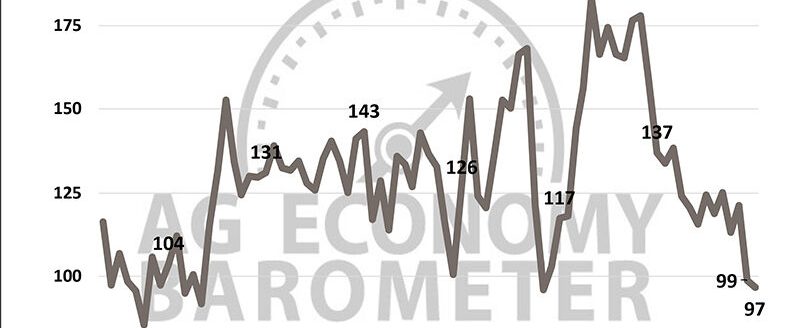Whole-Farm Revenue Protection workshops planned
Have you ever taken a large price dock at the elevator for light test weights, aflatoxin, low oil content, or other quality loss issues and discovered the quality protection in your crop insurance contract did not cover the loss?
There is quality loss coverage in your crop insurance contract, but it often doesn’t trigger, or the price dockage at the elevator is much larger than any quality loss triggered indemnity payment.
Whole-Farm Revenue Protection contract is being used by Pacific Northwest wheat-barley growers as a supplemental policy to cover low protein and other quality issues that are not effectively covered by Revenue Protection or Yield Protection crop insurance. We will explore the use of Whole-Farm Revenue Protection as a supplemental coverage to improve the quality loss protection for Great Plains’ crops in an upcoming workshop. This topic should be of interest to farmers who have had quality loss issues, crop agents, and lenders.
Whole-Farm Revenue Protection is a major topic at the Four-State Crop Insurance workshop next week sponsored by Kansas State University, Colorado State University, University of Nebraska, and Oklahoma State University. We have been conducting this conference for over 20 years. The workshop dates start next week in Colorado on Tuesday, Oct. 30; Nebraska on Wednesday, Oct. 31; Kansas on Thursday, Nov. 1 (in Salina); and Oklahoma on Friday, Nov. 2.
Readers will find a complete program brochure and a link to register online at: http://www.agmanager.info/events/kansas-crop-insurance-workshop.
WFRP is a stand-alone product, but it can also be used as a supplemental coverage product that is added to a Revenue Protection or Yield Protection contract. If used as a supplemental coverage, the WFRP premiums will be discounted to account for the RP/YP protection. There have been major improvements in the WFRP, and it would benefit many farmers to take a second look at the coverage, especially as a supplement.
We did an academic study on whole farm coverage for a beef cow operation about five to seven years ago and published it in the Journal of Agricultural and Applied Economics. At that time, WFRP didn’t provide the benefits we expected. However, there has been major changes to this contract that would benefit many farmers.
The largest concentration of WFRP participation is in the Pacific Northwest. They have used it as supplemental coverage on their basic RP or YP crop insurance contract covering wheat and barley. However, probably the biggest change was in 2015 when the WFRP subsidy was increased up to 80 percent of the premium and matches the subsidy rates for enterprise units.
As a supplemental coverage, WFRP will cover some perils that are not effectively insured by RP/YP. For example, a corn farmer who had only half of a crop this year effectively had a second deductible because in addition to yield loss, he also had quality losses.
This corn grower received a 54-cent dock at the elevator for light test weight and aflatoxin. However, this was not sufficient to trigger the quality loss protection in the RP coverage. He did receive an indemnity payment for yield loss.
RP does not cover basis loss on the price either. Many wheat farmers remember the large negative basis on the 2016 wheat crop that exceeded the expected basis by more than a dollar.
A similar development has occurred on soybean basis this year. WFRP pays on the cash price that would provide protection for both quality loss and basis loss. Many wheat- barley farmers in the Pacific Northwest have added WFRP as supplemental coverage to provide protection for some of these perils not effectively covered by RP/YP.
If expected cattle sales are under $1 million, the WFRP may be the best protection available for a beef cattle operation. The pasture and forage policy will have no effect on the WFRP payment calculation if the pasture and forage policy is on pasture and hay fed on the farm. Cash hay sales would affect the WFRP payment.
The WFRP contract has become a viable option for insuring an alfalfa hay farm where quality is extremely important. Alfalfa hay produced for cash sales or even international shipment may find WFRP to be the preferred protection plan because it will not only cover production and price, but also includes quality.
WFRP doesn’t effectively work for any farmer who actively hedges her crop on the CME. Gains in the futures markets are counted, but losses are not counted, reducing the amount of any indemnity payments.
However, if the same farmer uses forward contracts or HTAs, there is no negative impact on the WFRP claim. One would think a grower could set up a separate entity to trade the futures market, but that will take some legal-accounting advice. Given the complexity of futures trading, the best solution would be to delete the futures gains/losses from consideration in the WFRP loss adjustment.
WFRP is a complicated crop insurance contract because it is tied to a farm’s tax return. This makes the contract far more complicated than the standard crop insurance contract.
One would think farmers themselves would want a better understanding of WFRP before using it. While this workshop will not make farmers an expert, it will likely help growers to ask better questions of their agent.
Agents will need a lot more training on WFRP before selling the product than can be provided in this meeting. Most of the AIPs offer more in-depth training for their agents.
While time will limit the discussion of the details, K-State will cover many of the economic benefits and costs of WFRP. One probably would want answers to those economic questions before spending a great amount of time on the WFRP policy details. Because this is so different from a standard crop insurance contract and tied to a complicated tax return, it is unlikely if anyone will receive too much education.
Contact Rich Llewelyn at [email protected] or me at 785-532-1515 if you have any questions about this education program.


